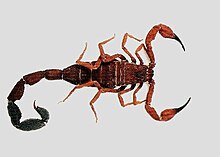
Scorpions are predatory arachnids of the order Scorpiones. They have eight legs, and are easily recognized by a pair of grasping pincers and a narrow, segmented tail, often carried in a characteristic forward curve over the back and always ending with a stinger. The evolutionary history of scorpions goes back 435 million years. They mainly live in deserts but have adapted to a wide range of environmental conditions, and can be found on all continents except Antarctica. There are over 2,500 described species, with 22 extant (living) families recognized to date. Their taxonomy is being revised to account for 21st-century genomic studies.

Blue-ringed octopuses, comprising the genus Hapalochlaena, are four highly venomous species of octopus that are found in tide pools and coral reefs in the Pacific and Indian oceans, from Japan to Australia. They can be identified by their yellowish skin and characteristic blue and black rings that change color dramatically when the animal is threatened. They eat small crustaceans, including crabs, hermit crabs, shrimp, and other small sea animals.

Latrodectus mactans, known as southern black widow or simply black widow, and the shoe-button spider, is a venomous species of spider in the genus Latrodectus. The females are well known for their distinctive black and red coloring and for the fact that they will occasionally eat their mates after reproduction. The species is native to North America. The venom can cause pain and other symptoms, but is rarely fatal to healthy humans.

Terciopelo, is a species of pit viper occurring at low to moderate elevations in northeast Mexico and Central America, and into South America where it is known from elevations up to 2600 meters in the Colombian and Ecuadorian Andes, as well as Venezuela and Trinidad on the Caribbean coast. With a mass up to 6 kilograms (13 lb) and the maximal length of 2.5 metres (8.2 ft), terciopelo is among the largest pit vipers. It is light to dark brown in color, often with yellow zig-zag-shaped lines on each side of the body. Dubbed "the ultimate pit-viper" for its large size, fangs and venom yield, it has a fearsome reputation, responsible for the most snakebites within its range because of its defensive temperament and proximity to human residence. However, in common with other venomous snakes, it avoids confrontation with humans whenever possible. No subspecies are currently recognized.
Tityustoxin is a toxin found in the venom of scorpions from the subfamily Tityinae. By binding to voltage-dependent sodium ion channels and potassium channels, they cause sialorrhea, lacrimation and rhinorrhea.

The striped bark scorpion is an extremely common scorpion found throughout the midsection of the United States and northern Mexico. It is perhaps the most frequently encountered scorpion in the U.S.

Rhinella icterica is a species of toad in the family Bufonidae that is found in northeastern Argentina, southern Brazil, and eastern Paraguay. "Cururu" is its indigenous name and refers to the male advertisement call that is a melodious tremolo. "Cururu toad", without the specifier "yellow", is a common name used for a few other closely related species.

Aphonopelma chalcodes, commonly known as the western desert tarantula, Arizona blond tarantula or Mexican blond tarantula is a species of spider belonging to the family Theraphosidae. It has a limited distribution in the deserts of Arizona and adjacent parts of Mexico but can be very common within this range. The common name "blond tarantula" refers to the carapace, which is densely covered in pale hairs, and contrasts strongly with the all-dark legs and abdomen. Additionally, these spiders have low toxicity, a long life expectancy, and several offspring.
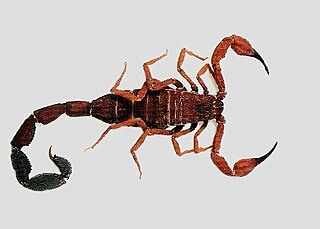
Tityus is a large genus of thick-tailed scorpions, the namesake of its subfamily Tityinae. As of 2021, Tityus contains more than 220 described species distributed in Central America and South America, from Costa Rica to Argentina. Species in the genus Tityus have been studied for hundreds of years, long before the taxonomic classification was put in place. Tityus tend to be of medium size for scorpions, roughly 50 to 70 millimeters long. They are dark brown or red in color, and can exhibit sexual dimorphism. They can live in a variety of environments, ranging from urban to arid mountains to the Amazon Rainforest. Tityus scorpions are best known for their venom and potent sting. The genus contains several dangerously venomous scorpions, the best known of which is the Brazilian yellow scorpion, T. serrulatus. Its venom can cause severe illness, and in the young, old and infirm even death. Some experts have argued that the genus as a whole may be paraphyletic, which could explain the knowledge gaps related to Tityus.

A scorpion sting is an injury caused by the stinger of a scorpion resulting in the medical condition known as scorpionism, which may vary in severity. The anatomical part of the scorpion that delivers the sting is called a "telson". In typical cases, scorpion stings usually result in pain, paresthesia, and variable swelling. In serious cases, scorpion stings may involve the envenomation of humans by toxic scorpions, which may result in extreme pain, serious illness, or even death depending on the toxicity of the venom.
Discrepin (α-KTx15.6) is a peptide from the venom of the Venezuelan scorpion Tityus discrepans. It acts as a neurotoxin by irreversibly blocking A-type voltage-dependent K+-channels.
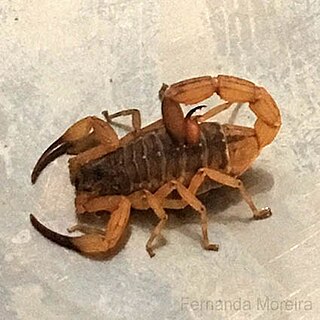
Tityus serrulatus, the Brazilian yellow scorpion, is a species of scorpion of the family Buthidae. It is native to Brazil, and its venom is extremely toxic. It is the most dangerous scorpion in South America and is responsible for the most fatal cases.

Bactridines are a group of six antibacterial peptides from the venom of the Tityusdiscrepans scorpion. They exclusively target sodium channels. Bactridines are unique in that this scorpion toxin acts on sodium channels of both bacteria and eukaryotes.
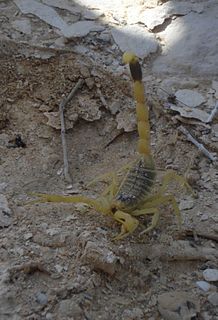
Leiurus abdullahbayrami is a species of scorpion in the family Buthidae. Its venom is highly toxic to humans, but can be used in medical development.

Scorpionism is defined as the accidental envenomation of humans by toxic scorpions. If the injection of venom in a human results in death, this is defined as scorpionism. This is seen all over the world but is predominantly seen in the tropical and subtropical areas. These areas include Mexico, northern South America and southeast Brazil in the Western hemisphere. In the Eastern hemisphere, scorpionism possess a public health threat in the regions of South Africa, the Middle East, and the Indian subcontinent.
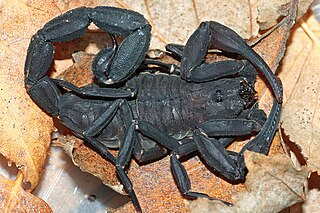
Tityus obscurus, known as the Amazonian black scorpion, is a species of scorpion found in northern South America.

Tityus pachyurus is a species of arachnid endemic to Central America and South America.

List of reported attacks and species involved in Latin America.
Tityus asthenes is a significantly venomous scorpion endemic to South America. Sometimes it is known as Peruvian black scorpion.

Hemiscorpius lepturus is a species of scorpion in the family Hemiscorpiidae. It is found in deserts of the Middle East, especially in southern Iraq and Iran. These scorpions have long, thin tails and wide bodies and grow to 8 cm in males and 5.5 cm in females, allowing them to live in tight rock crevices. They are fairly solitary creatures. H. lepturus has mainly been studied to discover the components and effects of its venom, which is highly lethal and is responsible for most deaths due to scorpion sting in the Iran area. H. lepturus is the only scorpion not in the family Buthidae that is potentially lethal; the Buthidae family is the largest and most abundant family of scorpions, containing many highly venomous species.
